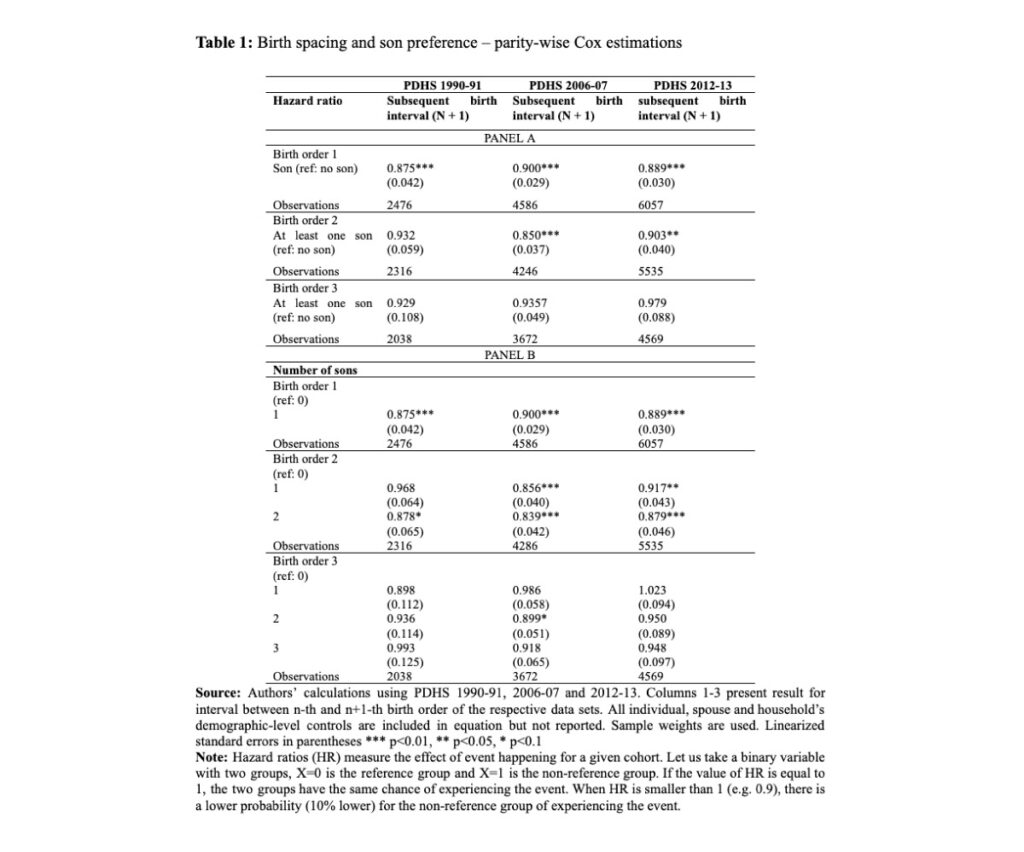Rashid Javed and Mazhar Mughal investigate how son preference affects birth spacing in Pakistan. The impact they find is strong, with several negative consequences on the demographic transition of the country and on the quality of life of its inhabitants, especially females.
Reducing gender bias and achieving gender equality is one of the 2030 Sustainable Development Goals (SDG 05). Son preference is a form of gender bias that persists in many parts of the developing world. The phenomenon has a number of economic, social and cultural causes. When insurance markets and social safety net programmes are missing, sons become a major economic asset, as they take up family businesses and cover parents’ old age needs. Conversely, daughters are considered an economic burden: parents must save for their dowry, and they leave home after their marriage to join their husband’s household. In Pakistan, for instance, women who bear sons often enjoy higher status at home and have more say in household decision-making, while women not bearing sons face social stigma (Javed and Mughal 2019).
Couples continue childbearing until they achieve the desired number of sons, and those with no sons at earlier birth orders go for the next child after a shorter interval (Milazzo, 2014). Shorter birth spacing leads to higher demands on the mother’s body and affects the nutrition and health of existing children (Kozuki & Walker, 2013). It is not by chance that the World Health Organization (WHO) recommends a minimum interval of 24 months between two consecutive births to reduce the risk of disease, malnutrition and mortality, particularly among girl children.
Pakistan’s case
In a recent study, we examined the son preference–birth spacing relationship in Pakistan, a populous, Muslim-majority country where son preference is widespread, even though, unlike in other son-preferring Asian countries such as China and India, sex-selective abortion is not commonly practiced. The reproductive effects of son preference are instead reflected in differential birth stopping and spacing patterns (Javed and Mughal 2020).
We employed data from three rounds of the Pakistan demographic and health survey (PDHS 1990-91, 2006-07 and 2012-13), restricting our sample to women who had completed their childbearing period with at least one child. Our outcome variable is the duration (in months) between parity n and subsequent parity n+1. For son preference, we used a number of indicators: at least one son at parity n, sex of the firstborn, number of sons at parity n, and overall sex ratio. We controlled for women’s individual characteristics (age, education, employment status, age difference with the husband, exposure to electronic media), husband’s education and household characteristics (family size, wealth, location and province of residence). As an estimation strategy, we employed an array of semi- parametric, non-parametric and parametric duration models.

We found a strong relationship between son preference and subsequent birth spacing. The effect is statistically significant at early birth orders but fades out beyond the third birth interval. Women with a son at birth order 1 are 10 % (1-0.90) to 13% (1-0.87) more likely to delay the second birth compared to women whose first child is a girl (Panel A). Likewise, women with at least one son out of the first two children are 10 % (1-0.90) to 15 %(1-0.85) more likely to delay the third birth compared to women without a son (Panel A). In the same vein, we find that women, whose two children are both boys, are 13 % (1-0.87) to 17% (1-0.83)% more likely to delay child births compared to women whose two children are girls (Panel B). We also found a role of son preference on the last birth interval. Women with sons only are 14-18% more likely to delay the birth of their last child than women with one or more daughters (results not shown).
We also found son preference to be associated with high-risk births. Women with at least one son are less likely to have subsequent birth spacing of less than 18 or 24 months (results not shown).
Another indication of this differential spacing is found in contraceptive prevalence, as women with one or more sons who do not report their fertility to be complete, are found to be more likely to use contraception than women with no sons (results not shown).
Conclusions
To summarize, we found conclusive evidence that Pakistani couples avoid contraception and shorten their subsequent birth interval to reach the desired number of sons. This manifestation of son preference has important consequences at national level. Connubial bliss may indeed require a son or two, but the disproportionate preference for sons that it entails affects the country’s demographic transition by hampering efforts to control rapid population growth, reduce high incidence of child and maternal mortality, and improve health outcomes. Pakistan has one of the highest child mortality rates in Asia (65 deaths per 1000 births), especially among girl children, which derives in part from the short birth intervals associated with excessive preference for boys. Maternal mortality is also high. Policy measures and awareness campaigns that promote gender equality in the country (and reduce son preference) can help lessen the occurrence of high-risk births, thereby not only lowering the risk to both mother and child’s life but also improving their health outcomes.
References
Javed, R., Mughal M. (2019) Have a Son, Gain a Voice: Son Preference and Female Participation in Household Decision Making, The Journal of Development Studies, 55(12), https://doi.org/10.1080/00220388.2018.1516871
Javed, R., Mughal M. (2020) “Preference for boys and length of birth intervals in Pakistan.” Research in Economics 74(2): 140-152. https://doi.org/10.1016/j.rie.2020.04.001
Kozuki, N., & Walker, N. (2013). Exploring the association between short/long preceding birth intervals and child mortality: Using reference birth interval children of the same mother as comparison. BMC Public Health, 13(SUPPL.3). https://doi.org/10.1186/1471-2458-13-S3-S6
Milazzo, A. (2014). Son Preference, Fertility and Family Structure: evidence from reproductive behavior among Nigerian women (English). World Bank Policy Research working paper no. WPS 6869, Washington, D.C.


